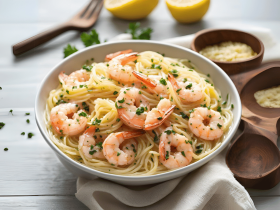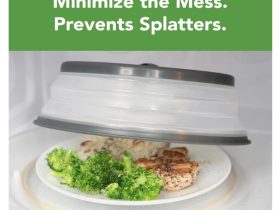Microwave covers help keep your microwave mess-free and your food nice and moist. They act as a barrier between the food and the interior of the microwave, preventing splatters of sauce or food particles from making a mess. Using a microwave cover also helps to evenly distribute heat, which can improve cooking results and reduce the need for stirring or flipping.
Does a microwave cover stop radiation? No, microwave covers do not block radiation; they simply help contain splatters and improve cooking efficiency. Knowing how to cover food in microwave settings can help optimize the process.
These covers come in various sizes to accommodate different dishes, and many are dishwasher safe for easy cleaning. With features like steam vents to release excess moisture, they ensure that food doesn’t become too soggy or overcooked. For those looking to save time on cleaning and want to enhance their microwaving experience, investing in a durable microwave cover is a practical choice.

✅ Why You’ll Love Using a Microwave Cover
1. Say Goodbye to Messy Microwaves
Tired of cleaning up splattered sauce or soup? A microwave cover acts like a shield, keeping all those messy bits off your microwave walls. Less mess means less stress.
2. Keeps Food Moist and Tasty
Nobody likes dry leftovers. Using a cover helps lock in moisture, so your food stays warm and juicy—not rubbery or dried out.
3. Helps Heat Food Evenly
Ever noticed cold spots in your reheated meal? Microwave covers help distribute the heat more evenly, giving you better results without the guesswork.
4. Traps Strong Odors
Some foods smell stronger than others (looking at you, leftover fish!). A cover helps keep those smells contained so your whole kitchen doesn’t take on the aroma.
5. Cuts Down Cleaning Time
Since your microwave stays cleaner, you’ll spend way less time scrubbing. Just rinse the cover and you’re good to go!
6. Reusable = Less Waste
Rather than using paper towels or plastic wrap each time, opt for a reusable microwave cover to protect your food.
❌ Things to Keep in Mind Before You Buy
1. They Can Be a Bit Bulky
Some microwave covers are large and may take up space in your kitchen drawers or shelves. Not ideal if you’re short on storage space.
2. Might Not Fit Every Dish
Got a big bowl or wide plate? Not all covers fit all dish sizes, so be sure to check the measurements.
3. Needs Regular Washing
Just like any kitchen tool, you’ll want to wash the cover after each use—especially if it’s been in contact with greasy or saucy food.
4. Watch Out for Cheap Plastic
Not all covers are created equal. Stick with ones that are BPA-free and labeled microwave-safe to avoid any health concerns.
5. Can Get Hot
Some covers can get pretty warm after use, so it’s a good idea to let it cool for a few seconds or use oven mitts to avoid burns.
The Importance Of Using A Microwave Cover
Many people use microwaves every day. Yet, not everyone uses a microwave cover. A microwave cover helps keep your microwave clean and makes your food taste better.
Preventing Food Splatters
- Covering the microwave helps prevent food from spilling.
- Keeps the microwave clean: Covers catch any food that tries to jump out.
- Cleanup-friendly: Much easier than cleaning the entire microwave.
- Less time spent on cleaning: Spend more time enjoying your meal.
- Say goodbye to scrubbing the microwave. Say hello to more playtime.
Retaining Moisture And Flavor
Food tastes better with a microwave cover. Here is how:
- Stops moisture from escaping: Keeps your meal juicy and delicious.
- Evenly cooked dishes: Helps cook food more evenly.
- Keeps flavors in: Your meal keeps all its tasty flavors.
- With a cover, your food not only stays moist but also keeps its yummy taste.
Types Of Microwave Covers
Microwave covers are great for keeping your microwave clean. They stop food from splattering. If you’re looking for the best food cover for microwave use, let’s explore the different types of microwave covers available. We will look at plastic, ventilated, and silicone covers.
Plastic Microwave Covers
Plastic microwave covers are popular and affordable. They come in many shapes and sizes. Cleaning and storing plastic covers is simple. Most are dishwasher safe. Some things to remember:
- Check for BPA-free labels to ensure safety.
- Plastic can melt, so don’t use high heat for long times.
- Look for handles to avoid burns when removing.
- Always use covers designed for microwaves. Not all plastic is safe.
Ventilated Microwave Plate Covers
Ventilated covers have holes to let steam escape. This feature prevents food from getting soggy. Here’s why they are helpful:
- Steam vents reduce cooking time by letting heat circulate.
- Adjustable vents allow you to control steam release.
- They are available in both glass and plastic, with plastic being the more lightweight option.
- Ventilated covers are great for reheating pizza or keeping rice fluffy.
Silicone Lids
Silicone lids are versatile and eco-friendly. It is extremely flexible and resistant to high temperatures.
- They can seal bowls of different sizes.
- Easy to clean, often dishwasher safe.
- They’re non-toxic and don’t hold smells.
Many choose silicone for its durability and safety. It’s a smart choice for families.
Choosing The Right Microwave Cover
Choosing the right cover for your food in the microwave is essential to avoid splatters and maintain a clean interior. It also promotes even heating, ensuring your meals are warmed thoroughly without the mess. With so many choices available, selecting the right microwave cover can be tricky. This guide is here to help you find the ideal one for your needs.
Material Considerations
Material choice is crucial for microwave covers. It determines durability, safety, and effectiveness. Here are some top materials:
- Plastic: Common and affordable. Make sure it’s BPA-free for safety.
- Glass: Lasts longer and is eco-friendly. It’s also dishwasher safe.
- Silicone: Flexible and good for high temperatures. It’s easy to store too.
Each material has its benefits. For example:
| Material | Pros | Cons |
| Plastic | Lightweight, transparent | Can warp over time |
| Glass | Sturdy, doesn’t absorb odors | Heavier, risk of breakage |
| Silicone | Collapsible, range of colors | Can retain stains with use |
Size And Compatibility
The right size cover fits your microwave and dishes. Compatibility is essential for effective use. Keep these points in mind:
- Measure the interior height and turntable size of your microwave.
- Choose a cover that allows at least one inch of space above the tallest dish.
- A cover too small won’t protect properly. One too large may not rotate.
Also, think about storage:
- Some covers are collapsible, saving space.
- Others come with magnets or hooks for easy access.
Remember, a cover needs to fit your microwave and dishes. It should also be easy to store.
Tips For Using A Microwave Cover
A microwave cover is a handy kitchen accessory. It helps keep your microwave clean. Say goodbye to messy food splatters. It also ensures even cooking. We will explore some essential tips. These tips will make your microwave experience better.
Proper Ventilation
A cover needs to let steam escape. Steam buildup can lead to soggy food. It can also cause pressure issues. Look for covers with vents. This allows hot air to circulate. It also lets steam out. Always check the cover’s fit. It should not be too tight. This helps prevent steam from getting trapped.
- Choose a cover with vents. This helps steam escape.
- Ensure the cover fits but is not too snug.
- After heating, remove the cover carefully. Hot steam can burn.
Avoiding Overheating
Microwave covers can get hot. Materials matter. Always use microwave-safe covers. Check the label for this information. Some covers can melt or warp. This can ruin both the cover and your food. Use a timer. Don’t heat food for too long. This helps prevent the cover from getting too hot.
- Use only microwave-safe covers.
- Check the maximum heating time on the cover’s label.
- Don’t heat for too long to avoid melting.
Cleaning And Maintenance
Keeping your microwave clean is important for both hygiene and efficiency. A microwave cover is a handy tool that helps keep food splatters inside the microwave to a minimum. This reduces cleaning time and extends the life of your appliance. Proper maintenance and cleaning of your microwave cover, including learning how to clean microwave waveguide cover, are essential. This guide will give you tips on how to do it right.
Dishwasher Safety
Many microwave covers are safe to clean in the dishwasher. This makes cleaning them simple and hassle-free. Always check the manufacturer’s guidelines before placing your cover in the dishwasher. Here are some tips to ensure your cover stays in top shape:
- Place the cover on the top rack to prevent warping from the heat.
- Use a mild detergent and avoid high-heat drying cycles.
- If the cover has a vent, ensure it’s free of food particles before the wash.
If your microwave cover isn’t dishwasher-safe, don’t worry. You can clean it by hand using warm soapy water. Rinse it well and let it air dry or pat it dry with a clean towel.
Stain Removal
Stains on microwave covers can be stubborn. Yet, removing them is possible with the right approach. Here’s how you can tackle tough stains:
- For recent spills, use a damp cloth to wipe away residue.
- For tough stains, create a mixture of two parts baking soda to one part water.
- Apply the paste to the stain and let it sit for five minutes.
- Gently scrub the area with a soft brush or cloth.
- Rinse the cover thoroughly and dry it.
If stains persist, try using a solution of equal parts water and white vinegar. Soak the cover for 15 minutes, then clean as usual. This method can help remove even the toughest of stains.
Common Misconceptions About Microwave Covers
Many people use microwave covers, but some don’t understand them well. There are myths about these covers. This post will clear up those myths. We will talk about how safe they are and how well they work. By the end, you’ll know more about microwave covers.
Microwave Safety
Using a microwave cover is all about safety. Microwave covers help stop food from splattering. This keeps the microwave clean. Many think covers can catch fire or melt, but that’s not true if you use them right. Good covers are made from microwave-safe materials. Always look for the microwave-safe label before buying. Here are important safety tips:
- Use only microwave-safe covers: Check the bottom for a label.
- Don’t seal food completely: Let steam escape to avoid pressure build-up.
- Avoid plastic wraps: They can melt and may contain harmful chemicals.
Remember, metal is a big no-no in microwaves. It can cause sparks and even fires. So, never use a cover with metal parts inside a microwave.
Effectiveness Of Covers
Do microwave covers work well? The answer is yes. A cover’s job is to keep moisture in and prevent dry food. It also helps food cook evenly. Without a cover, you might find cold spots in your food. Here’s what a good cover does:
- Keeps food moist: It traps steam to stop food from drying out.
- Reduces cooking time: Trapped steam can cook food faster.
- Prevents splatters: Your microwave stays clean and safe to use.
Many covers also have vents to let out extra steam. This is good because it stops food from getting soggy. Make sure to clean your cover often to keep it effective.
Innovations In Microwave Cover Technology
The microwave is a kitchen staple, and protecting it is key. Microwave covers shield food from splatters. They keep the microwave clean. Innovations in Microwave Cover Technology have made these covers smarter. They are better for the environment and more useful in various ways.
Eco-friendly Options
Our planet needs us to make better choices. Eco-friendly microwave covers do just that. They are made from materials that don’t hurt the Earth. Here are some key points:
- Biodegradable materials: These covers break down over time. They don’t stay as trash forever.
- Recycled plastics: Some covers use plastic that’s been used before. This reduces waste.
- Silicone alternatives: Silicone covers are durable. They can be used many times. They replace single-use covers.
These choices help to reduce our carbon footprint. This means less harm to our planet.
Multi-functional Designs
Today’s microwave covers do more than just cover food. They come with multi-functional designs. These designs make life easier. Let’s look at some features:
- Steam vents: These help cook food evenly. They let out steam so food doesn’t get too wet.
- Handles: They make it easy to lift the cover. No more burns or spills.
- Built-in strainers: Some covers can drain water. This is great for veggies or pasta.
These covers save space and time. They make cooking simpler. They are smart choices for any kitchen.


Frequently Asked Questions
Yes, using a cover when microwaving is better. It helps in even heating, prevents splatters, and retains moisture in food. Always use microwave-safe covers for safety.
The safest microwave covers are made from BPA-free plastic or silicone. They should also be labeled as microwave-safe to ensure they don’t leach chemicals into food.
Cover a microwave with microwave-safe glass rather than plastic to avoid chemicals leaching into food. Glass is also more heat-resistant and durable.
Use a microwave-safe plate, wax paper, parchment paper, or a paper towel as alternatives to a microwave cover. These options effectively prevent splatters, ensuring your microwave stays clean. Always check for safety and suitability for microwave use before opting for these substitutes.






















Leave a Reply